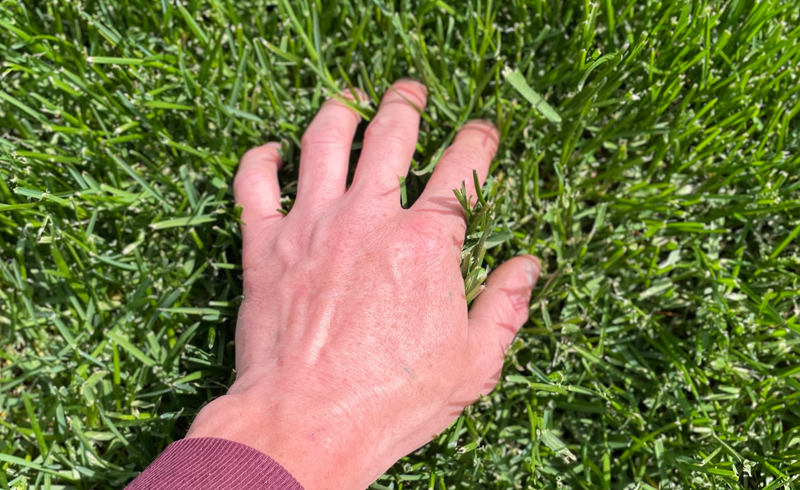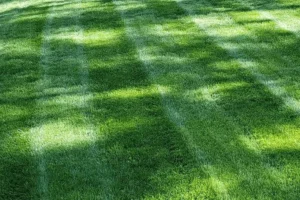
A Snapshot of St. Augustine Grass: The Favorite for Sunny Lawns
St. Augustine grass is a name that resonates with many gardeners and landscapers, especially those from warmer regions. The lush, green carpet graces countless lawns, turning gardens into verdant paradises. With its broad, flat blades and its love for the sun, this grass variety has become a top pick for those looking to add a touch of tropical beauty to their outdoor spaces.
But as every gardener knows, not all grasses are created equal. While St. Augustine thrives in the sun and heat, it has traditionally been a bit shy regarding colder temperatures. This has limited its use to specific regions, leaving many wishing to enjoy its beauty year-round, even in cooler climates.
Why Some Grasses Shiver While Others Thrive in the Cold
Nature is full of mysteries, including how different plants react to the cold. Just as some people love the chill of winter while others bundle up at the slightest breeze, grasses, too, have their cold-weather personalities. Some varieties go dormant, turning brown and waiting patiently for warmer days. Others, however, seem to have a natural antifreeze, staying green and vibrant even when Jack Frost pays a visit.
For gardeners and landscapers, this cold tolerance isn’t just a quirky plant trait; it’s a crucial factor in deciding which grass to plant. After all, no one wants to see their beautiful lawn turn into a brown patchwork when winter arrives. This is where the quest for a cold-loving St. Augustinegrass begins, promising the best of both worlds: tropical beauty that can stand up to winter’s chill.
St. Augustinegrass 101
Tracing the Roots: Where This Popular Grass Comes From
St. Augustinegrass is like the superstar of the grass world, especially in warmer regions. But have you ever wondered about its origins? This grass has a history as vibrant as its color. Native to the coastal regions of both the Mediterranean and the Gulf of Mexico, it’s accustomed to sandy soils and salty breezes. Over time, gardeners have embraced it far and wide, making its way into lawns across the globe.
Its adaptability is genuinely remarkable. Whether it’s the sunny shores of Florida or a backyard in Texas, St. Augustinegrass feels right at home. Its ability to thrive in various conditions, from salty soils to areas with moderate shade, has made it a favorite among gardeners. It’s not just about its looks; it’s about its resilience and versatility.
The Ideal Conditions: From Sunny Days to Just the Right Amount of Water
Every plant has its preferences, and St. Augustinegrass is no exception. Imagine it as a sun-loving friend who enjoys a good drink now and then. This grass loves basking in the sunlight, making it perfect for open lawns with plenty of natural light. But it’s not all about the sun; it also needs its fair share of water to stay lush and green.
While it’s tolerant of a variety of conditions, there are a few things that make it truly thrive. Regular watering, especially during dry spells, ensures it stays hydrated and healthy. And while it can handle some shade, ensuring it gets a good dose of sunlight will keep it at its vibrant best. For those looking to have the perfect St. Augustinegrass lawn, it’s all about finding that sweet spot between sunlight and hydration.
Why Cold Tolerance Matters
The Battle of Warm-Season Grasses Against Winter’s Frost
Every gardener has faced that moment of suspense: winter is approaching, and you’re wondering how your beloved plants will fare. This suspense is even more palpable for those with St. Augustine grass lawns. Being a warm-season grass, it loves the sun and warmth. But this grass is challenged when winter rolls in with frosty fingers. It’s like watching your favorite summer-loving friend enter a snowstorm without a jacket.
Now, while some plants and grasses go into a deep winter slumber, turning brown and dormant, others manage to brave the cold. This ability to withstand cold temperatures without significant damage is called ‘cold tolerance.’ For gardeners and landscapers, this isn’t just a fancy term; it’s the difference between a green winter lawn and a frostbitten one. It’s the hope that comes spring; your lawn will bounce back, vibrant and full of life.
Winterkill: The Nightmare of Every Gardener and Landscaper
If there’s one word that sends shivers down the spine of every gardener, it’s ‘winterkill.’ It sounds as ominous as it is. Imagine putting in all the effort to nurture and care for your lawn, only to see patches of it damaged or killed by winter’s harsh conditions. It’s like watching your masterpiece get erased, one frosty night at a time.
St. Augustinegrass, with its warm-season nature, is particularly vulnerable to winterkill. Those brown patches that appear after a cold spell? That’s Winterkill in action. It’s not just an eyesore but heartbreak for anyone who loves their lawn. This is why the quest for cold-tolerant St. Augustinegrass is so crucial. It’s about giving gardeners and landscapers a chance against winter’s wrath, ensuring that their lawns remain a source of pride, no matter the season.
Unraveling the Secrets of Cold Resistance
Nature’s Antifreeze: How Plants Gear Up for the Cold
Just like we bundle up in layers and sip on hot cocoa to keep warm during chilly days, plants have strategies to combat the cold. It’s fascinating that these stationary beings, which can’t move to a warmer spot or light a fire, have evolved ways to withstand freezing temperatures. Think of it as nature’s antifreeze, a set of internal mechanisms that help plants brace themselves against the frost.
For many plants, this involves a process called ‘cold acclimation.’ As the days get shorter and temperatures drop, plants sense these changes. In response, they undergo several internal changes, like producing particular proteins and altering their cell structures. It’s like a plant wearing a winter coat preparing for the cold days ahead. For gardeners, understanding this natural antifreeze can be the key to helping their plants, including St. Augustinegrass, survive the winter.
Preparing for Winter: The Magic of Cold-Acclimation
Cold acclimation might sound like a term from a science textbook, but it’s a magical process happening in our backyards. As the first chills of autumn set in, plants don’t just stand there waiting for winter to hit them. They get to work, preparing themselves for the icy days ahead. It’s like how squirrels gather nuts or birds migrate south; every living being has its winter survival strategy.
Cold acclimation is about building resilience for St. Augustinegrass and many other plants. It’s about strengthening cell walls, storing energy, and ensuring the plant’s vital processes continue even in freezing conditions. For gardeners and landscapers, this is a beacon of hope. It means that with the proper care and understanding, it’s possible to help our lawns and gardens survive and thrive during winter. And as research continues, we’re uncovering more and more about how to harness the power of cold acclimation to protect our beloved green spaces.
Behind the Scenes: The Cold Tolerance Tests
Hunting for the Toughest Grass in the Chilliest Spots
Imagine being on a quest, not for hidden treasures or ancient artifacts, but for the most challenging, resilient St. Augustinegrass. That’s precisely what the researchers embarked on. They scoured the chilliest spots where the cold was biting and relentless to find samples of St. Augustinegrass that had braved the elements. It’s like searching for that one warrior in a vast army who has faced countless battles and emerged victorious.
Collecting these samples was about more than just finding the hardest grass. It was about understanding its secrets. How did it manage to thrive in such cold conditions? What made it different from its peers that withered away? By studying these champion samples, the researchers hoped to uncover the mysteries of cold tolerance, paving the way for more resilient St. Augustinegrass varieties in the future.
The Lab Showdown: Putting St. Augustinegrass Samples to the Freeze Test
Once the samples were collected, it was time for the real showdown. Picture a state-of-the-art lab where these grass samples were put to the ultimate test. It’s like a reality show challenge but for grass. The goal? To see which samples could withstand freezing temperatures and emerge unscathed.
The process was meticulous. Each grass sample was placed in controlled environments, mimicking the cold conditions they might face in a real-world winter. The temperatures were lowered, and the grass was observed for signs of damage or distress. It was a test of endurance, resilience, and sheer willpower. For gardeners and landscapers, the results of these tests could be game-changing. It meant having St. Augustinegrass that could face winter head-on and come out on top, keeping lawns green and gorgeous all year round.
Revelations from the Research
The Champions of Cold: St. Augustine Grass Varieties that Surprised Us
As the results from the cold tolerance tests started pouring in, a few St. Augustinegrass samples began to stand out. These were the champions, the varieties that defied expectations and showcased an impressive ability to withstand the cold. It was like discovering a hidden talent in a contestant you’d underestimated. These grass samples weren’t just surviving; they were thriving, showing minimal damage even after exposure to freezing conditions.
For gardeners and landscapers, this was exciting news. It meant there were indeed varieties of St. Augustinegrass out there that could brave the winter and come out looking lush and green. These champions offered a glimpse into the future, a promise of lawns that could stay vibrant even in the coldest months. It was a testament to the resilience of nature and the wonders of scientific research.
A Game-Changer? What These Findings Mean for Your Lawn
The implications of these findings were vast. If specific varieties of St. Augustinegrass could resist the cold, it opened up new possibilities for lawns everywhere, especially in regions that experienced colder winters. No longer would gardeners have to watch their beautiful lawns turn brown and lifeless as winter set in. Instead, they could look forward to a verdant oasis, even amidst the snow and frost.
But beyond the immediate joy of a green lawn, these findings also hinted at broader changes in gardening and landscaping practices. With cold-tolerant St. Augustinegrass varieties, landscapers could experiment with new designs and layouts, confident that their creations would withstand the winter. Gardeners could explore new combinations of plants and grasses, creating diverse and resilient ecosystems in their backyards. In essence, the revelations from the research were not just about a single grass variety; they were about reshaping the future of gardening and landscaping.
Wrapping Up: The Future of Frost-Resilient Lawns
The Promise of New St. Augustinegrass Varieties for Colder Regions
The discoveries from the research have opened up a world of possibilities. Imagine a future where St. Augustinegrass isn’t just confined to tropical and subtropical regions but can flourish even in areas with biting winters. The champion varieties identified in the study are like the pioneers of this new era, showcasing the potential of what’s possible.
For gardeners and landscapers, this is a dream come true. No longer would they be limited by the traditional boundaries of where St. Augustinegrass can grow. They could now envision lush, green carpets of this grass even in previously considered too-cold regions. It’s like expanding the canvas for a painter, offering more space to create and innovate. The promise of these new varieties is not just about resilience; it’s about redefining the gardening landscape.
Greenhouse vs. Real World: The Next Steps in Cold Tolerance Research
While the findings from the lab tests are undoubtedly exciting, the journey continues. As any seasoned gardener knows, conditions in a controlled environment like a greenhouse can be quite different from the unpredictable nature of the real world. So, what’s next for these champion St. Augustinegrass varieties? Field tests. It’s time to see how they fare in a lab and out in the open, exposed to the elements.
These field tests are crucial. They will validate the lab findings, ensuring the cold tolerance observed in controlled conditions translates to real-world resilience. The field tests are the final hurdle for gardeners and landscapers eagerly waiting to plant these new varieties. Once cleared, it paves the way for a new generation of St. Augustinegrass, ready to grace lawns across a broader range of climates. The future looks green, and it’s all thanks to the relentless pursuit of knowledge and innovation.
FAQ
What is the main objective of the study on St. Augustinegrass?
The study aimed to determine if experimental St. Augustinegrass germplasm samples had different morphological differences compared to industry standards, ‘Raleigh’ and ‘Palmetto’.
Why is there a need for shade and cold tolerant turfgrass?
With homeowners moving towards greater energy efficiency, there’s an increasing demand for shade-tolerant turfgrasses. Using shade to cool homes and buildings has become more prevalent, leading to the need for turfgrass that can thrive in shade and cold conditions.
How were the St. Augustinegrass samples established for the study?
The study conducted a field trial with eight St. Augustinegrass samples. This included two industry standard cultivars, ‘Raleigh’ and ‘Palmetto’, and six experimental samples. They were established using 7 plugs per plot, covering 0.24m2.
What measurements were taken to evaluate the morphological differences?
The study took turf height measurements, visual seedhead density counts, and morphological measurements to quantify leaf width, leaf length, and internode distance.
Were there any significant differences found in the morphological traits of the grass samples?
Yes, there were significant differences in leaf width, leaf length, and internode distance. Turf height and seedhead density also varied when compared to the industry standards, ‘Raleigh’ and ‘Palmetto’ St. Augustinegrasses.
How does genotypic sequencing play a role in distinguishing between cultivars?
Genotypic sequencing isn’t always definitive in distinguishing between cultivars. In some instances, genotyping-by-sequencing couldn’t consistently differentiate standard cultivars from each other.
How were the plots maintained during the study?
Plots received irrigation as needed to prevent drought stress. They were mowed twice weekly during the growing season, treated with postemergence herbicides as required, and trimmed monthly to prevent encroachment.
Were there other methods used to determine differences between cultivars?
Yes, morphological characteristics were one tool used to identify differences between cultivars. As technology advances, genetic sequencing might offer more definitive ways to determine if these grasses are genuinely different.
RIS Credits
TY – JOUR
T1 – Screening Cold Tolerance in St. Augustinegrass (Stenotaphrum secundatum (Walt.) Kuntze) for USDA Hardiness Zone 7
A1 – McCarty, LB
A1 – Gambrell, NJ
JO – Int J Agri Res Env Sci
VL – 4
IS – 1
SP – 1
EP – 4
Y1 – 2023
ER –

Bob Green, a passionate lawn care enthusiast with over two decades of landscaping experience, is this website’s proud owner. His vast knowledge of horticulture and dedication to helping homeowners maintain beautiful lawns are reflected in the valuable content he shares on his platform. John has always been interested in Agrostology.














